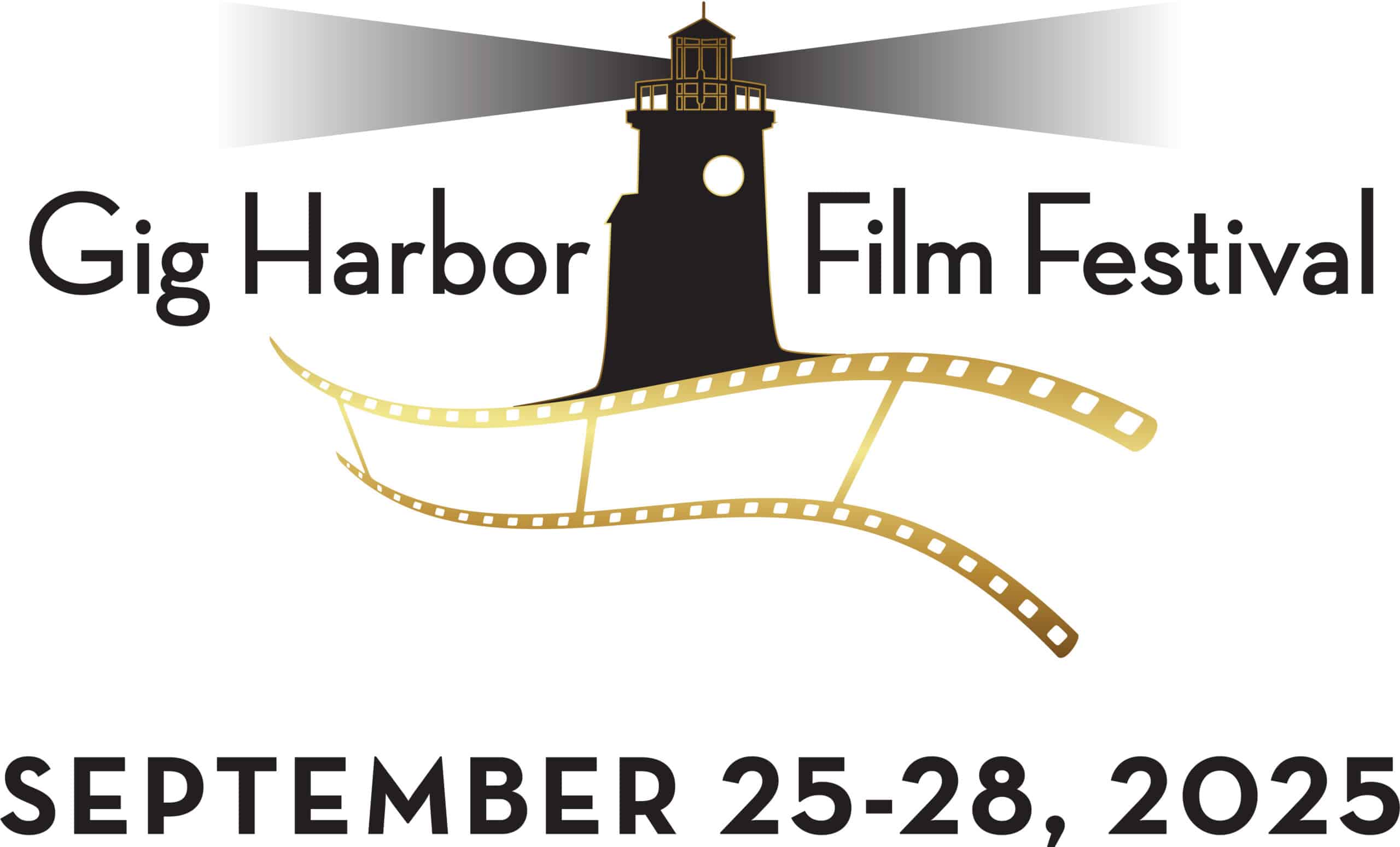Arts & Entertainment Community
Day Tripper | Exploring Tacoma’s Theater District
Everyone knows where Tacoma’s Stadium District is. Just look for the castle with a superlative view of the mountains and sound that doubles as a high school.
Arts & Entertainment Sponsor
Arts & Entertainment stories are made possible in part by the Gig Harbor Film Festival, a proud sponsor of Gig Harbor Now.
And most people know where Tacoma’s Museum District is — between about 15th and 21st Streets on both sides of Pacific Avenue. But what about the area between these districts?
Theater District
At first I wasn’t even sure what this district is called. Part of this region used to be downtown Tacoma. A half-century ago, it was a typical bustling shopping district in a mid-sized city featuring department stores, specialty shops, local businesses and restaurants. The other end housed Old City Hall, local theaters and social organizations.
Tacoma is no different than other major cities. Time, the economy, and a pandemic were not kind to the downtown area as evidenced by an exhibit at the Tacoma Historical Society.
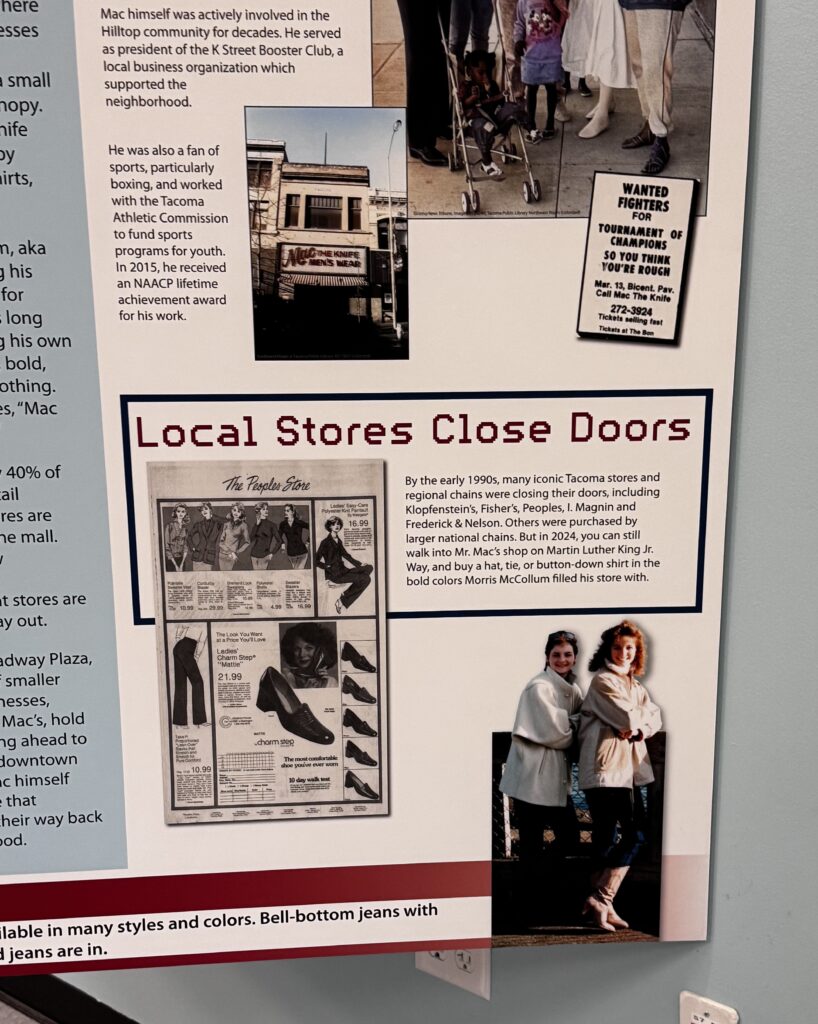
An exhibit at the Tacoma History Museum discusses the struggles of local businesses starting in the early 1990s. Photo by Mary Williams.
Once I actually started exploring this region, it was clear to me that this is Tacoma’s Theater District. Of the more than 100 pictures I took, my phone labeled every single one as “Theater District.” I guess that question has definitely been answered.
We ended up deciding to explore this area on a blustery afternoon just before Christmas. Our initial destination was the art supply store on St. Helens near Sixth. The side of this building features a painting that is part of the city’s Mural Project. You’ll see others as you roam around, particularly as you walk down Opera Alley.
I learned that there are 35 murals around town, painted between 2010 and 2017. I’m thinking Day Tripper may need to take a day to check them all out. I’ll use this robust website to guide my journey.
As I’ve said before, stay tuned.
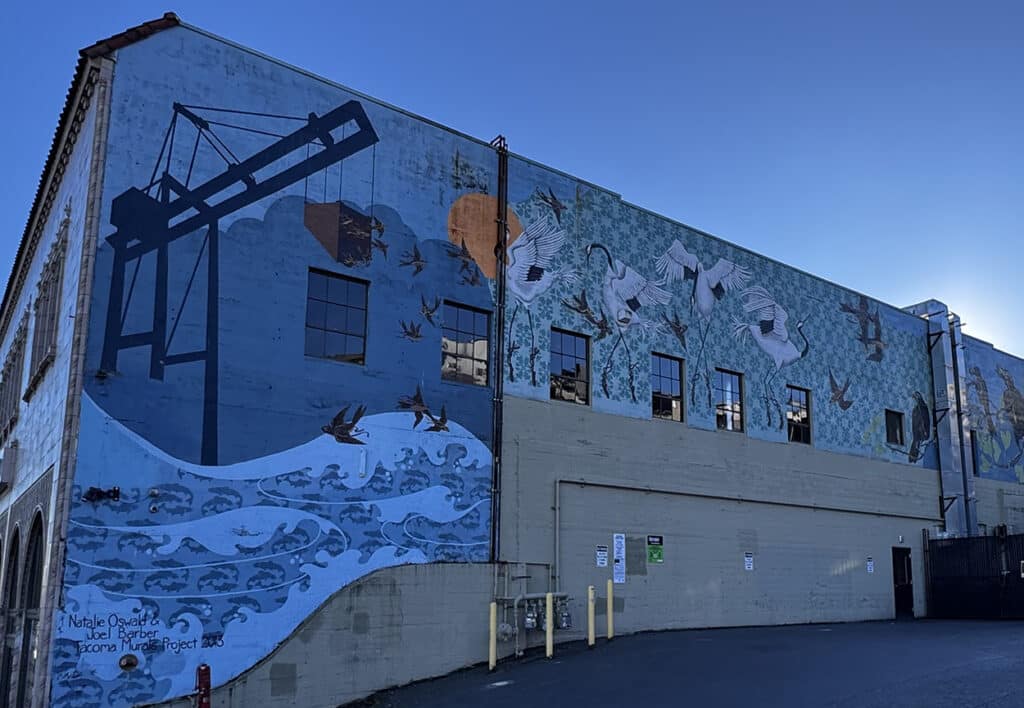
A Tacoma Mural Project painting. Photo by Mary Williams
I decided to distract my young granddaughters while their mom did some last-minute shopping, so we wandered down to McMenamins Elks Temple thinking we could escape from the wind and check out their decorations.
The exterior of the building is impressive. After a series of questions that I couldn’t answer about the eclectic hotel interior, the Spanish Steps and the Old City Hall clock tower (inquiring 7- and 9-year-old minds want to know), I decided I needed to pay a return visit. Now that I have most of the answers, I think we’ll all come back so that I can appear to be a much smarter gramma.
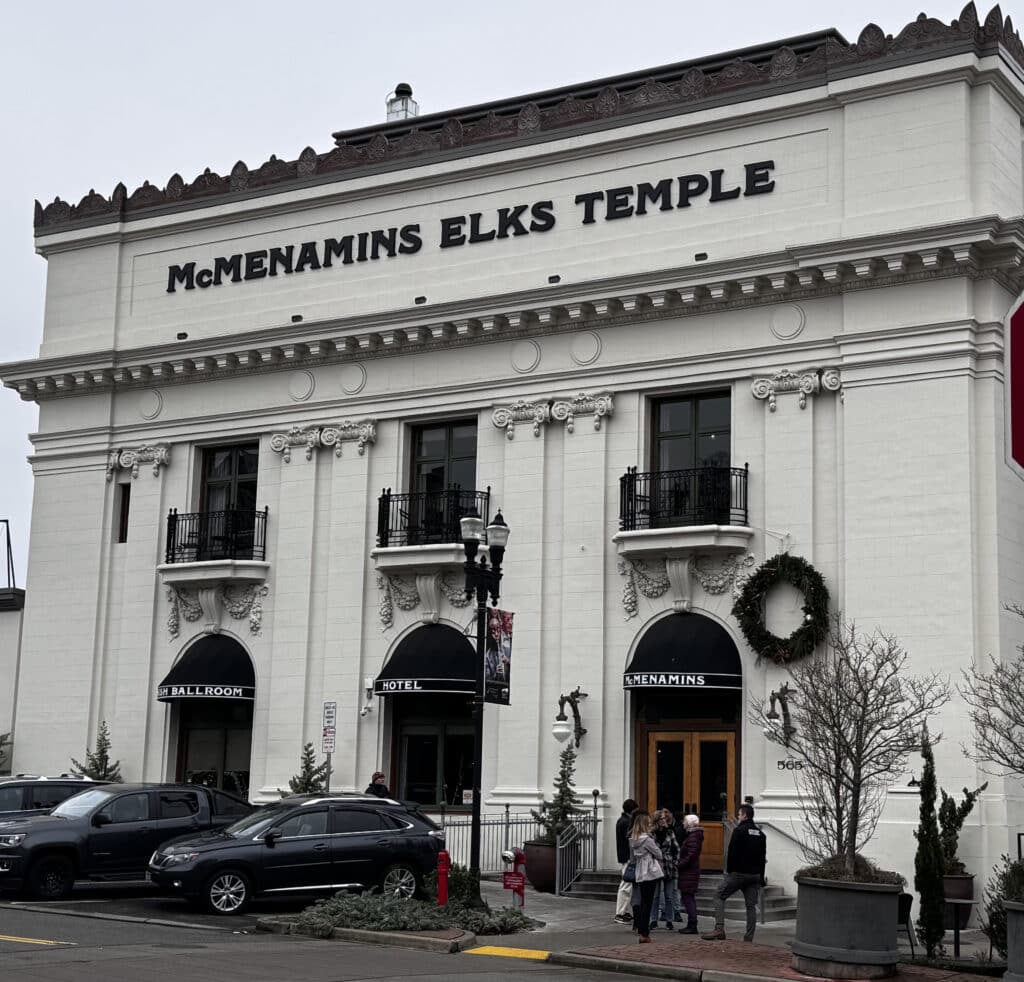
The distinctive McMenamins Elks Temple in Tacoma. Photo by Mary Williams
McMenamins Elks Temple
The first comment came as we were approaching the building. “That’s so funny, Gramma! Everyone knows elks don’t go to church.”
I was tempted to launch a discussion about different kinds of elks and temples, but I restrained myself. Instead, I decided to learn more about the history of the building and the source of its name.
The Elks organization was created in New York when a group of entertainers decided to find a way to help people who had fallen on hard times.
In 1868, the Benevolent and Protective Order of the Elks was created. While many other groups called their meeting places lodges, the Elks chose temple to reflect the importance of the space for members. Many Elks temples are notable for their grand architecture, often built in a prominent location within a community, and reflecting the organization’s desire to be visible and engaged with the public.
The Tacoma Grand Elks Temple opened in 1916 and grew to 15,000 members, at one time the largest in the country. The original building was in the second Renaissance Revival style. Designed by É. Frère Champney, it is now listed on the National Register of Historic Places.
In the 1950s, the club outgrew the facility and the Elks moved out. A new owner allowed many community organizations to use the building for various events, but that stopped after the owner died in 1986.
The building basically sat vacant for more than 30 years. Soon it was a disaster: Abandoned, neglected, vandalized, and covered with graffiti.
The McMenamin brothers purchased the property in 2007. McMenamins is a Pacific Northwest beer brewer/pub operator/restaurant company that specializes in the restoration and conversion of historic buildings.
Long remodel
After several years of remodeling and over $30 million, the new hotel is amazing! It has been restored and reimagined into a vibrant gathering place. Every nook and cranny is decorated with period pieces of furniture, artwork of all kinds, mementos of times gone by, and fixtures that represent the entire 110-year history of the organization and community.
The place is a maze. All seven floors have been restored, although the fifth floor is tiny and hard to find. The building now includes a McMenamins Brewery, the Bottle Shop & Brewery Tasting Room, and The Old Hangout on the ground floor. The Spanish Steps lead to the Spanish Bar and Ballroom on the second floor and then continue to Broadway. Doc’s is a third-floor games bar overlooking the ballroom.
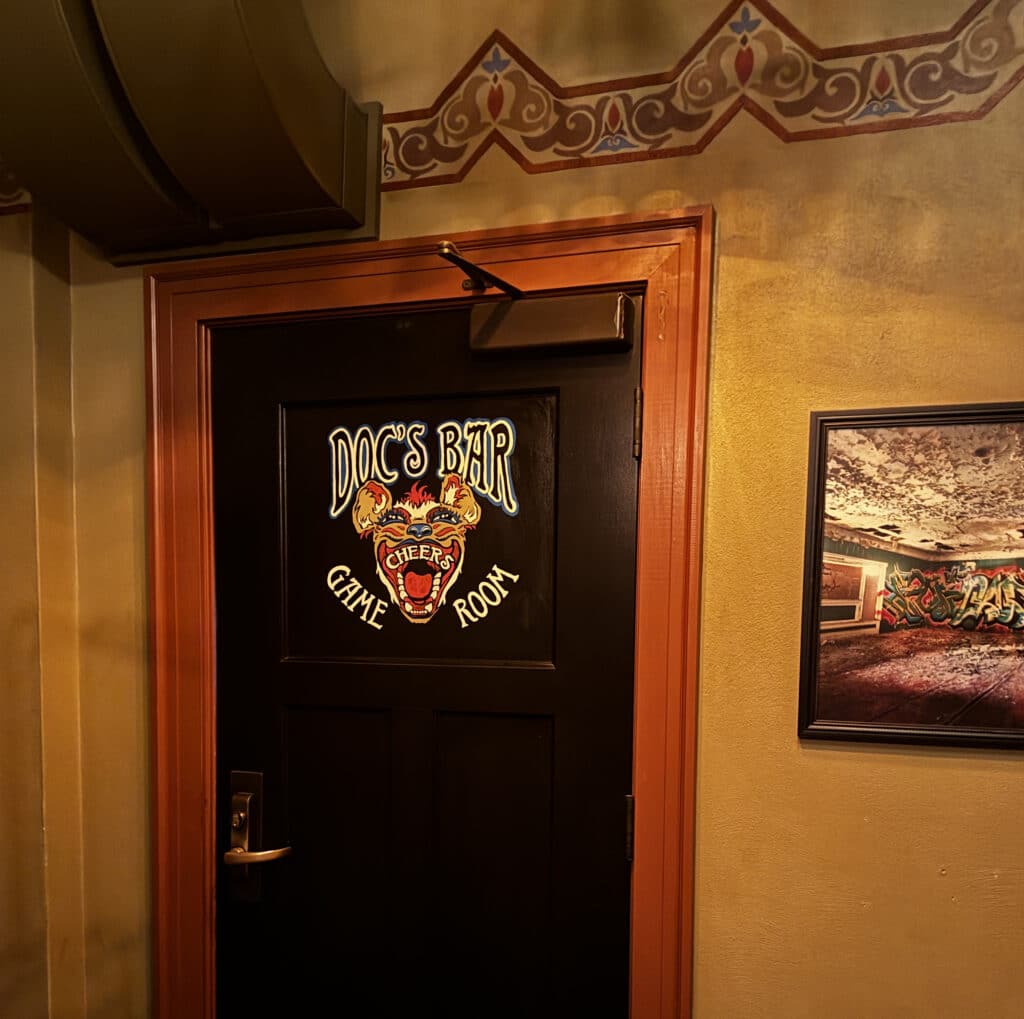
Doc’s Bar inside McMenamin’s Elks Temple in Tacoma. Photo by Mary Williams
The fourth floor features the building’s main entrance on Broadway. There you’ll find the hotel registration desk and the entrance to McMenamins Pub. If you decide to have lunch or dinner in the Pub, be prepared to be distracted by the expansive views of Commencement Bay and the marina at Foss Waterway. Thankfully, you’ll also find an elevator that will take you to the higher floors.
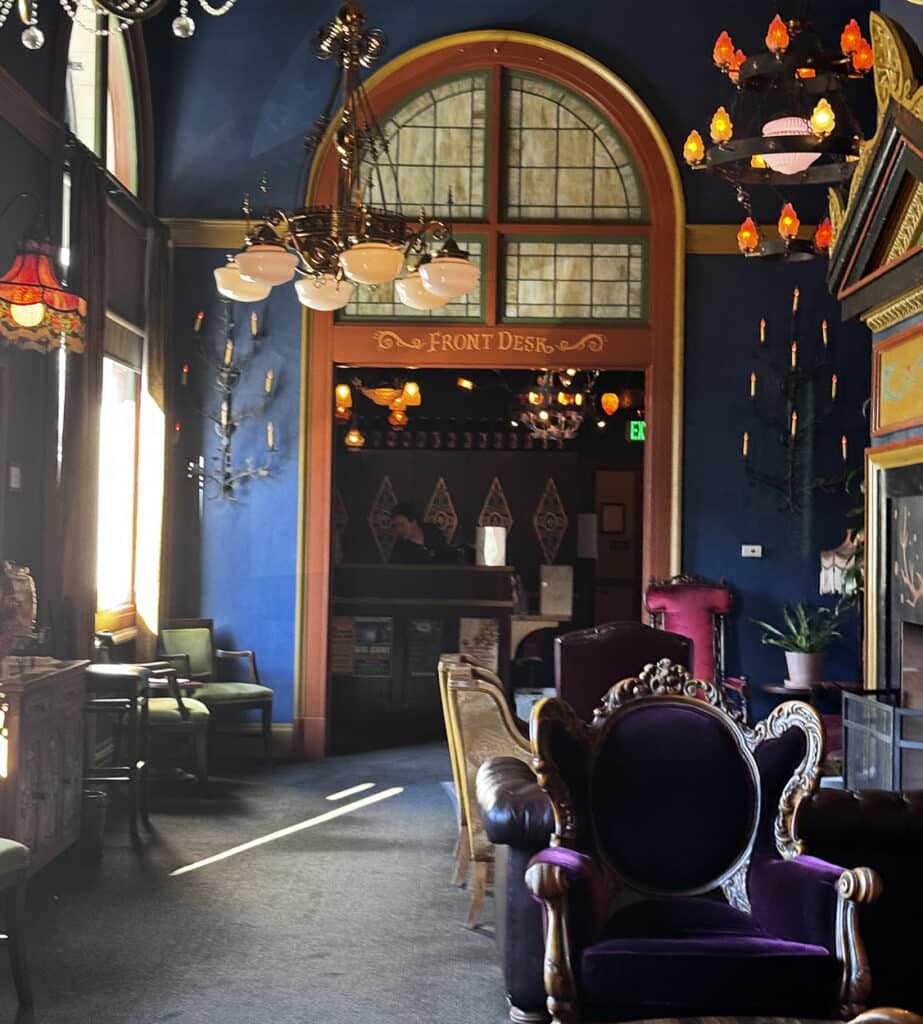
The lobby of McMenamins Elks Temple in Tacoma
If you go all the way to the top, floor seven, you’ll find both guestrooms and interior windows that overlook the lush indoor atrium below and a light display like no other. Together the sixth and seventh floors include 45 rooms.
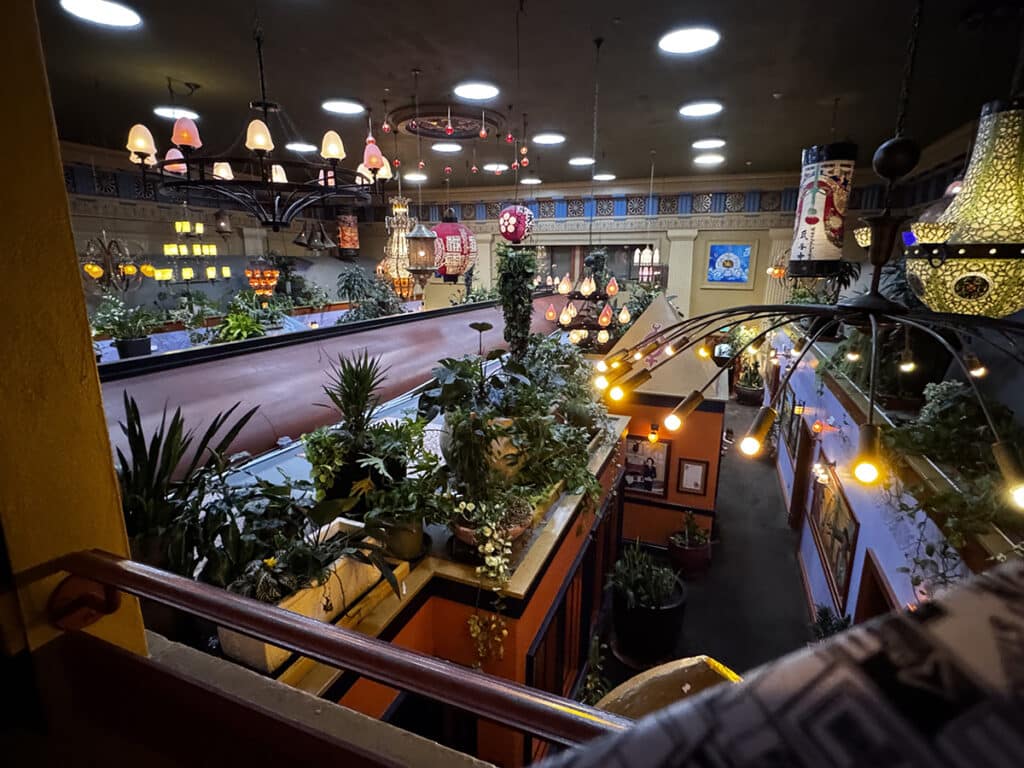
The atrium at McMenamin’s Elks Temple in Tacoma. Photo by Mary Williams
The sixth floor is home to additional guestrooms and a spectacular overhead array of lights, lamps and chandeliers. Guest rooms have all been named after people or organizations that have been instrumental in the history of the area’s development. One mural on this floor that I found interesting was an artist’s depiction of the demise of Galloping Gertie.
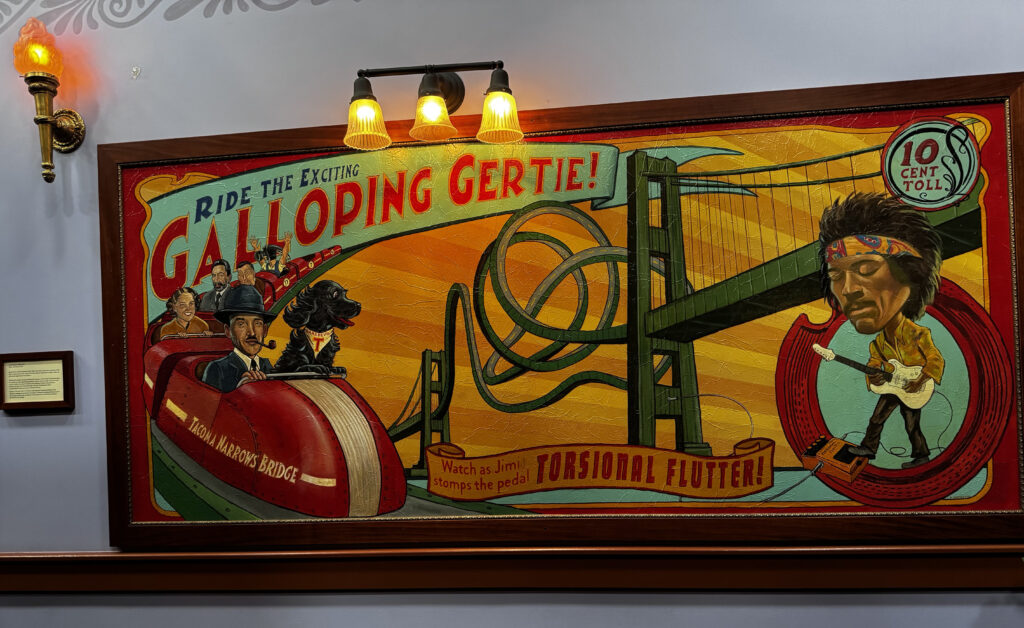
Artwork at McMenamins Elks Lodge in Tacoma. Photo by Mary Williams
The fifth floor is the mystery floor that you really have to hunt for. This was the topic of the next question: “Gramma, why isn’t there an elevator button for floor 5?”
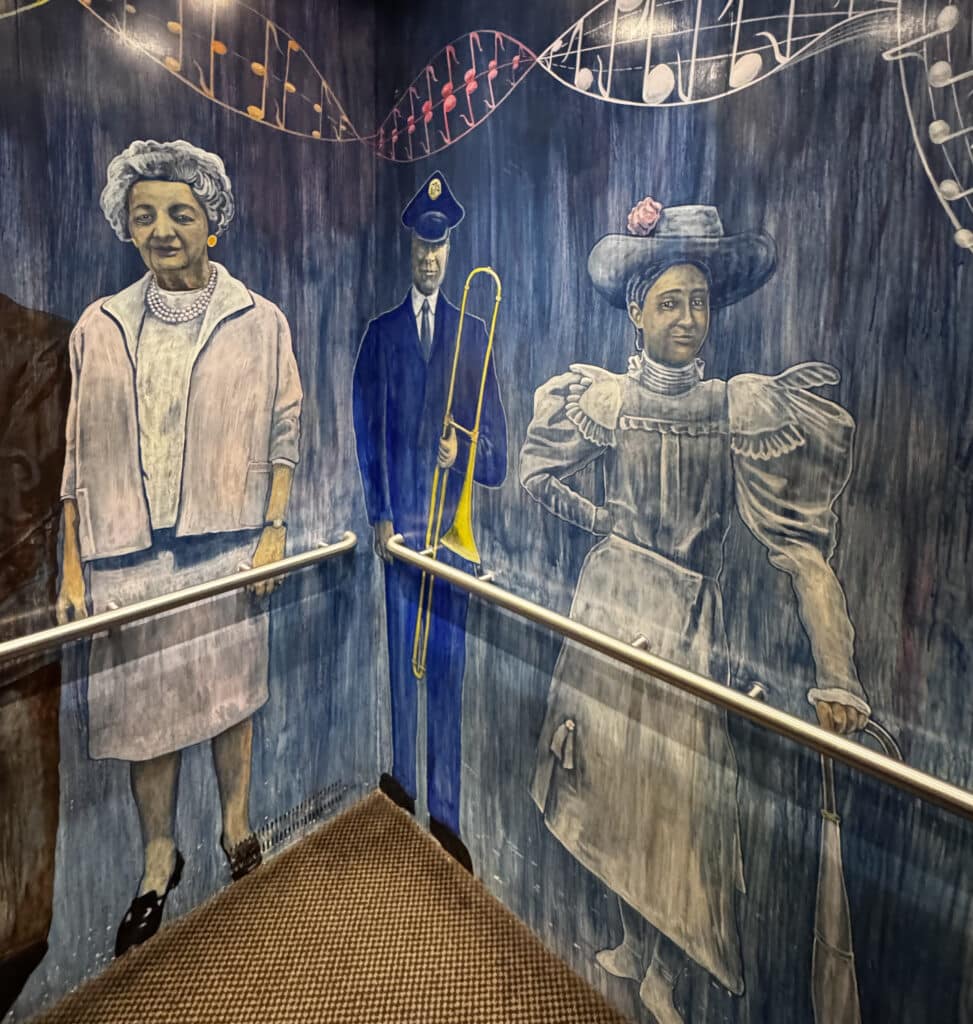
The inside of an elevator at McMenamins Elks Temple in Tacoma. Photo by Mary Williams
It took a reconnaissance mission to track down the missing floor and answer the question. It really is little more than a large landing between floors four and six, accessible only by stairway 1 in the southeast corner of the building. Despite its petite size, it is not lacking in artistic elements. If I wanted to curl up in a cozy chair and reflect on all I’d seen and done in this amazing facility, this is where I’d go.
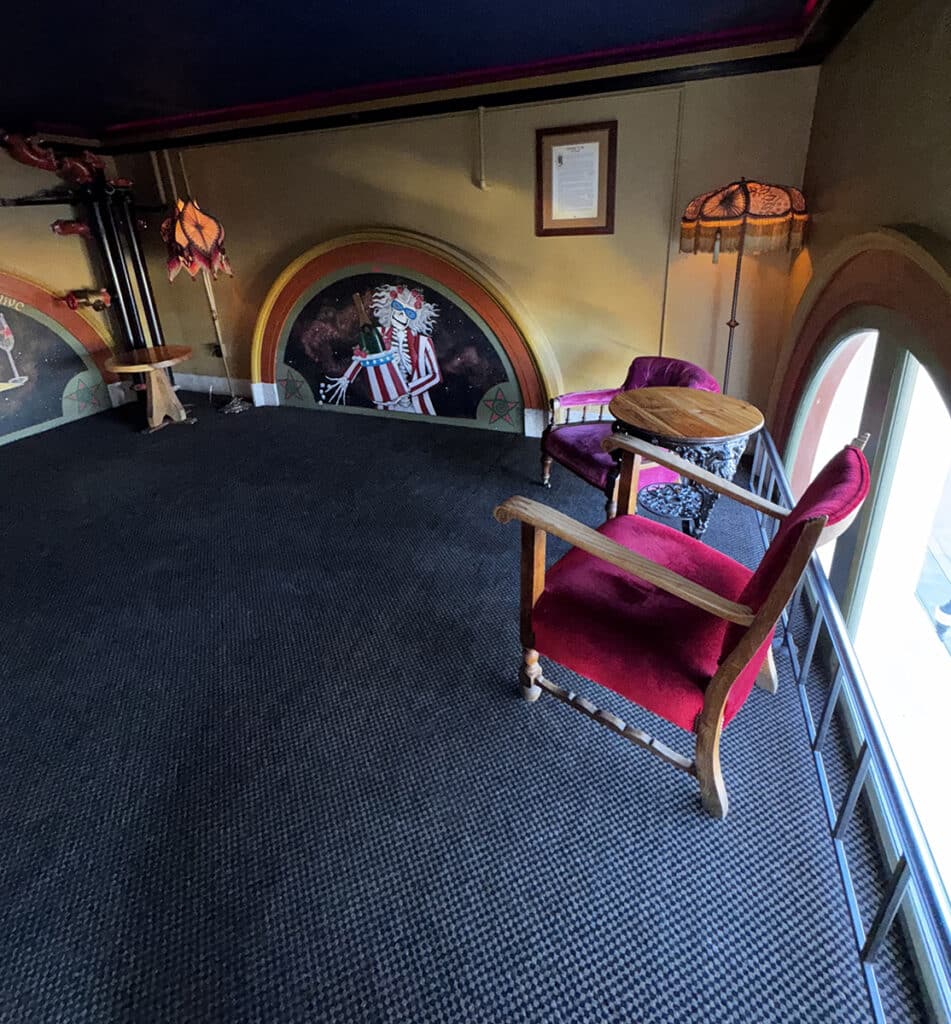
The fifth floor. Photo by Mary Williams
Originally, the fifth floor was anticipated to be a full floor, but as changes were made during the design and construction process, it disappeared chunk by chunk until only a cozy corner remained.
The Spanish Steps
The hillside adjacent to the Temple features a stairway called the Spanish Steps, named after the more-famous Spanish Steps in Rome.
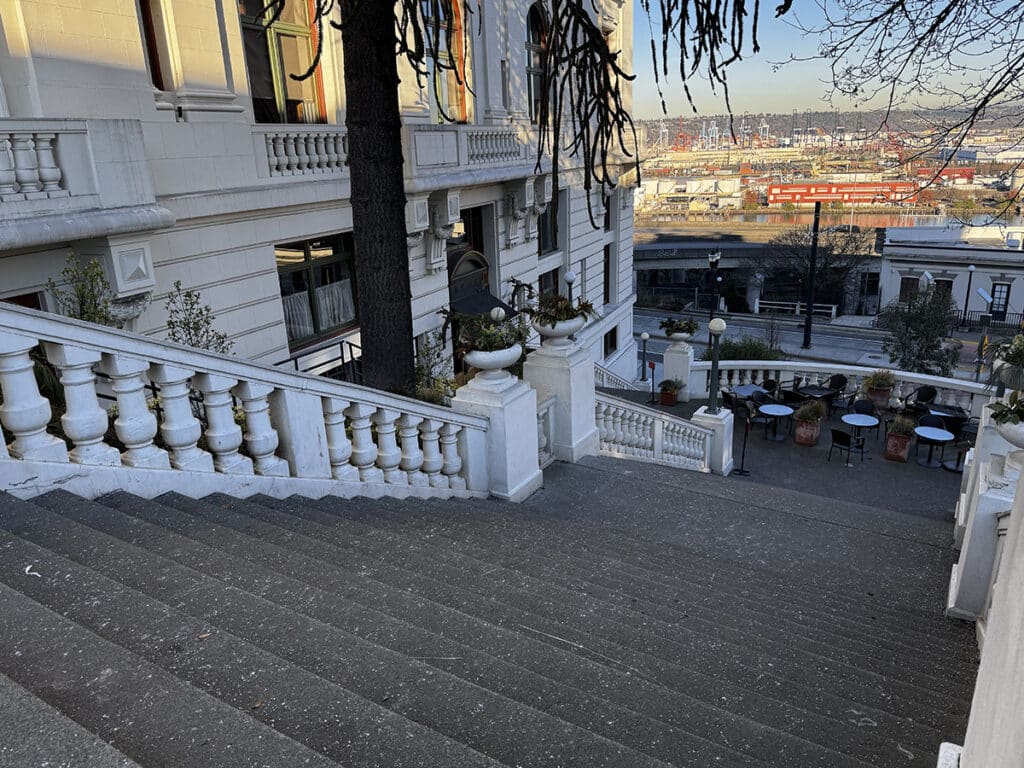
The Spanish Steps. Photo by Mary Williams
There are differences between the original and its Tacoma replica. Rome’s Spanish Steps were completed in 1725, while Tacoma’s were originally constructed in 1916 to connect the Broadway streetcar line with the Old City Hall on Commerce.
The staircase fell into disrepair in the 1950s and continued to disintegrate until it was hazardous and unusable. Fortunately, the city of Tacoma rehabilitated it in 2011. Not surprisingly, the steps now connect the Old City Hall area to the entrance to the Hotel’s Spanish Ballroom.
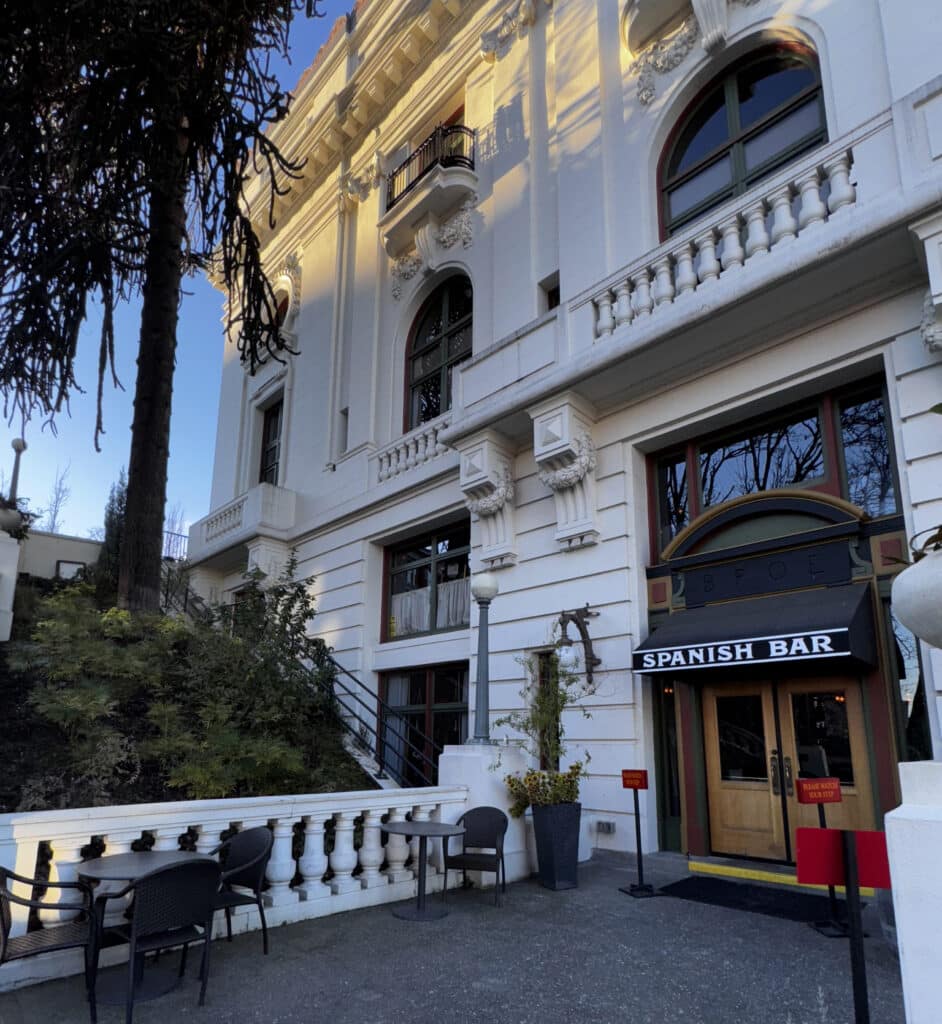
Entrance to the Spanish Bar at McMenamins Elks Temple. Photo by Mary Williams
The stairway’s history has not been controversy-free. The Elks hired Édouard Frère Champney to create a design that also called for a grand public staircase. Once the stairway was completed, the Elks disputed the word ‘public’ for more than two decades. In the 1930s, they actually tried closing off the staircase. The issue was finally resolved when the city public works commissioner — who was also an Elks Club member — ruled that the Elks did not actually own the staircase. It has been public property (and a public responsibility) ever since.
Opera Alley
If you actually walk all the way up the Spanish Steps, or step out of the front doors of the Elks Temple, directly in front of you is a sign for Opera Alley. While it is officially known as Court C, particularly after it crosses Ninth Street, the street got its nickname because it ran behind the Tacoma Theater on Broadway, which was originally an opera house.
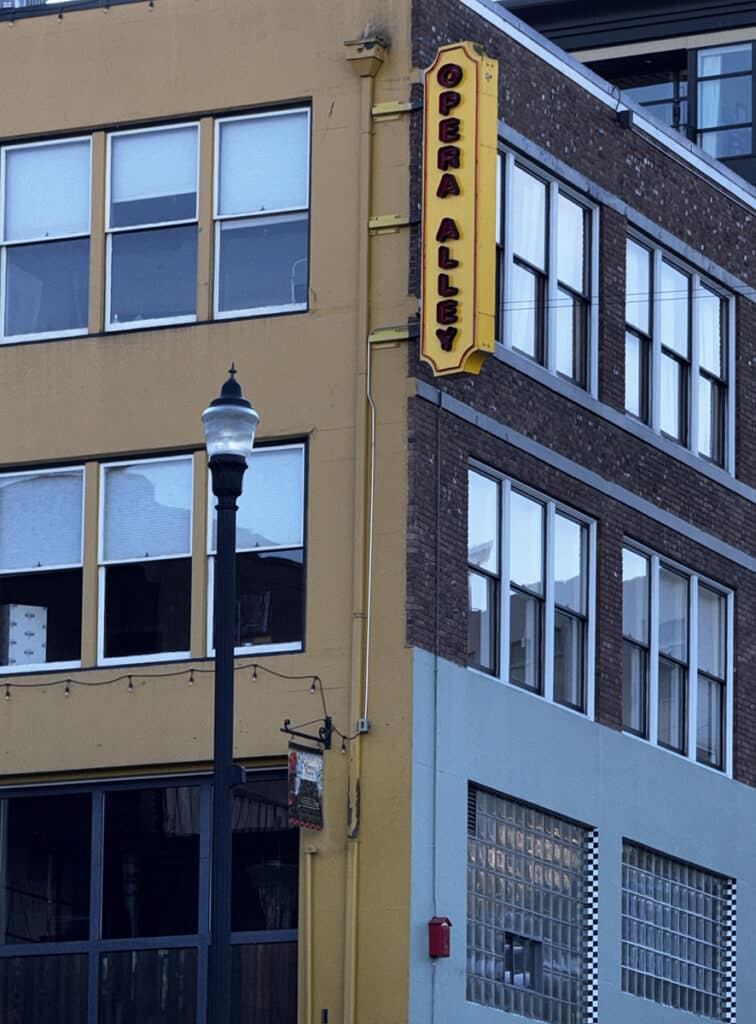
Opera Alley
It was also home to the city’s first post office. From the 1920s until about 1960, Opera Alley was distinctive for another reason. It was one of the most notorious red-light districts on the entire West Coast. Now it’s the home to several small businesses and vintage stores.
Antiques, vintage and just junk
This area is nothing if not confusing. Opera Alley ends at St. Helens, which just a couple of blocks later merges with Broadway at Ninth Street. Perched at the lower end of the steep hill that rises precipitously from Pacific Avenue until it levels off around Tacoma Avenue is an area full of antique and vintage stores. Several of them have upper and lower store fronts on both Commerce Street and Broadway Street with floors of everything old that you can imagine. You need to check them out for yourself. I’ll let you decide whether your find is an antique, a collectible, or just junk.
Theaters
At the junction of Broadway, St. Helens, and Ninth Street are the Pantages and Rialto theaters. At one time, the area was also home to the famed Tacoma Theater.
The venue featured the largest stage in the area and welcomed a who’s who of the entertainment world during the late 19th and early 20th centuries. A fire destroyed it in 1963, just after the City Council had allocated significant funding for its restoration.
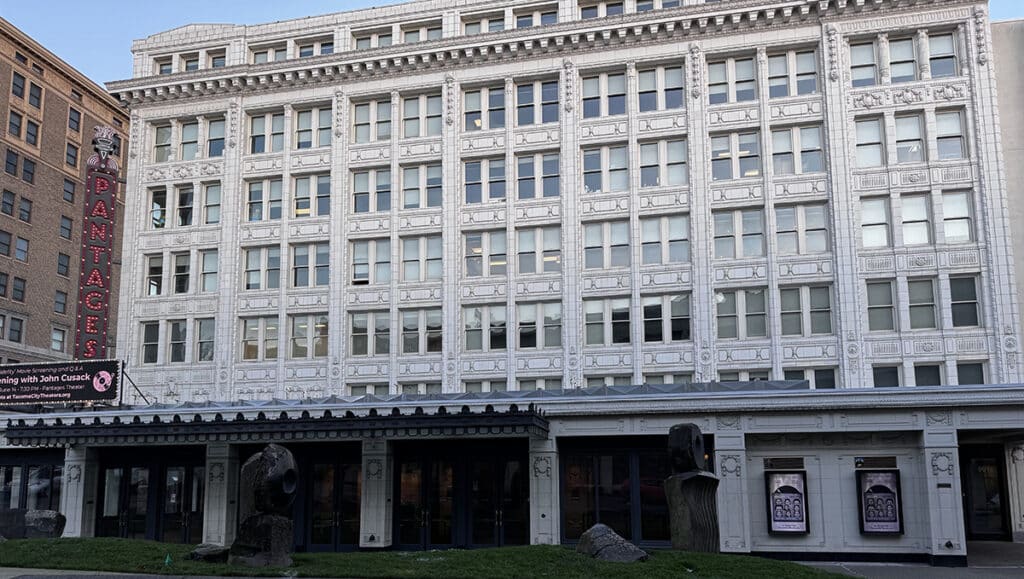
Pantages Theater in Tacoma. Photo by Mary Williams
The theaters that were built on either side of the Tacoma Theater in 1918 – the Pantages and Rialto – still stand and anchor the city’s current theater district.
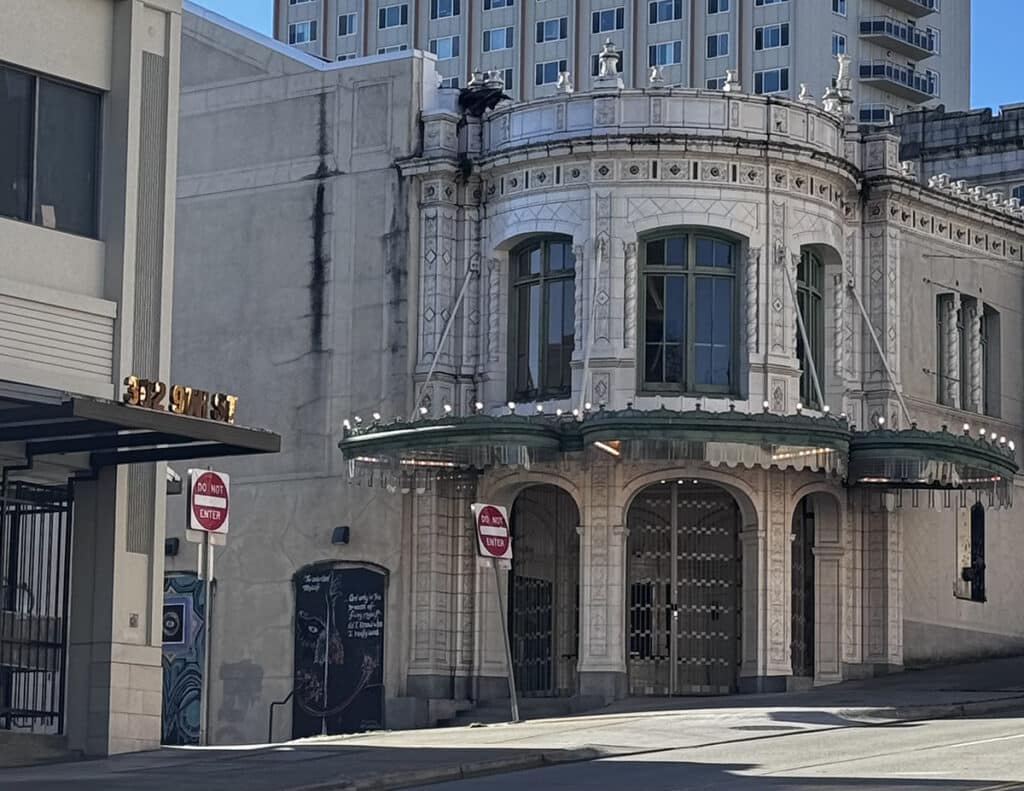
Rialto Theater in Tacoma. Photo by Mary Williams
Fireman’s Park
Walk down Ninth Street, cross Pacific (carefully of course), and look for a grassy area. Fireman’s Park nestles between Seventh and Ninth on A Street along the waterfront. It was originally the site of Engine House No. 6, which was built in 1890 and demolished in 1974. The park also was home to a totem pole that was considered its centerpiece. It was said to have been carved by Alaskan Natives and stood in the park for over 100 years.
Just after the turn of the century, the city undertook a project to stabilize the 110-year-old pole. A combination of natural aging, wet conditions, and many infestations of carpenter ants had caused severe deterioration. Bracing and a steel pole were used to stabilize it. After the investment of about $85,000, the work was completed with much fanfare.
Within a couple of years, under increased scrutiny by experts from local tribes and after many complaints, it was determined that the pole was a fraud and not representative of the Puyallup Tribe. The pole was removed in August 2021 and sawed into six pieces. The four mid-sections were given to the Puyallup Tribe, while the top and bottom were donated to the Tacoma Historical Society.
The disgraced pole was removed from the Tacoma Historical Register in 2021. Tacoma officials say they plan to commission new Coast Salish art for the park.
Old City Hall and the Clock Tower
As you walk through the park, it curves around and fronts Pacific Avenue across the street from the backside of the Old City Hall. Cross the street and walk toward the freeway a bit. You’ll find a fenced-off crumbling area that was once the original city jail. Only history and the ghosts within know what went on in there.
The original Tacoma City Hall was built in 1893, during a depression. Old City Hall, 625 S. Commerce St., was designed to look like an Italian Renaissance town hall with fine brickwork, tall windows and sweeping archways. It was completed in 1893 at a cost of $257,965 and was used by the city until 1959. It is a five-story building.
A clock and bell tower added in 1904 added another 10 stories. The clock and a set of four bells were cast by the McShane Bell Foundry, which also cast the Liberty Bell.
The bells were removed during restoration because they were a seismic hazard and conflicted with current building codes. The clock pendulum is 12 feet long, suspended on a single 40-foot-long wire.
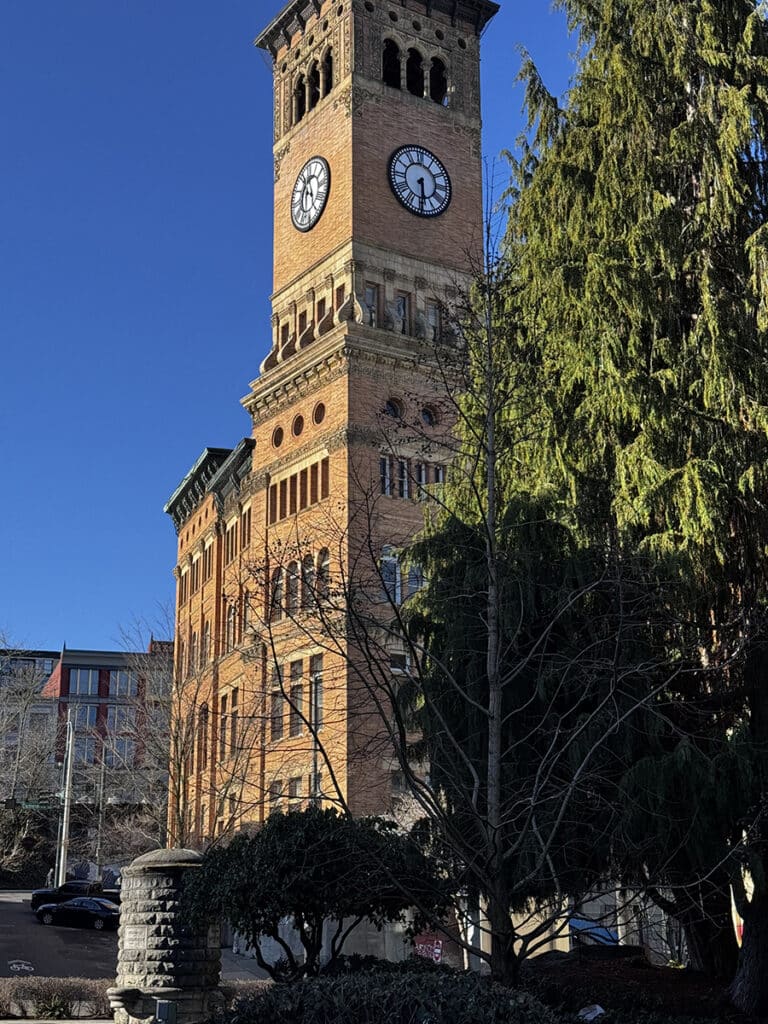
The Old City Hall building in Tacoma. Photo by Mary Williams
City government used Old City Hall for 64 years. OCH saw Tacoma through many eras, from the turn of the 20th century to the Great Depression and both World Wars. At various times, the 80,000-square-foot building housed the Tacoma Public Library, city government, attorneys, and the city jail.
Over time, these entities relocated to other facilities. Tacoma city government moved out in 1957. The stately building, once a beehive of activity, was officially vacant. There was no real incentive to maintain a vacant building, so the deterioration and decay began and continued unchecked.
The Delphinium Gardening Club fought for the historic site and saved it from demolition, and Tacoma’s Old City Hall was added to the National Registry of Historic Places in 1974. Renewed interest led to yet another revitalization and efforts to modernize the facility. At one point in the ’80s, about 40 local businesses had a presence there.
Once again, shifting economic trends led to a high vacancy rate and a shortage of funds for maintenance. The last tenant of Old City Hall vacated in the wake of the 2008 financial crisis. The building owners made small improvements before finally abandoning it once again.
The Tacoma City Council awarded Surge Tacoma the right to purchase and redevelop OCH in March 2019. The purchase price was $2 million, plus $2 million in in-kind donations over the next 10 years. The project spells out the inclusion of 40 micro-apartments, two restaurants, retail space, a basement speakeasy, and offices and co-working space.
Full circle
It’s time to cross Broadway, going from the front steps of Old City Hall to the base of the Spanish Steps. If we go up the steps, we’ll be back at the fourth-floor front door into McMenamins. But, instead of doing that, walk 100 feet to the first floor rear entrance to the temple and go inside. That’s where you’ll find the Bottle Shop, the Brewery, and the Old Hang Out.
But wait, there’s more!
So I find myself back at the location that caught my attention and imagination in the first place. My original intent was to also investigate Wright Park and some of the area surrounding it on this trip.
So, I’ll be coming back. In February, we’ll explore the park, the Stadium District and some of the beautiful homes nearby. There’s all sorts of history here that I can’t wait to investigate on my next day trip. I hope you’ll join me.
About the Day Tripper column
Gas prices are sky high, and a night in a hotel is approaching astronomically expensive. So, for the foreseeable future, I imagine many of you are going to find yourselves taking day trips rather than the road trip vacations we’ve grown to love.
This beautiful region in which we live is ripe with opportunities to explore new places, see new things, and learn a little something at the same time. I promise to keep the longest journeys to a one-way distance of under 200 miles. Whether you want to make it an overnight trip, a weekend, or just a very long day trip, we should be able to pull it off.
I hope you’ll grant me the honor of your virtual company as we travel these roads together. Happy trails!

